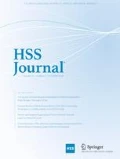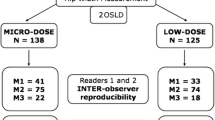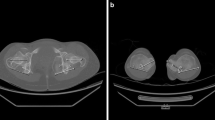Abstract
Background
EOS low-dose biplanar X-ray used with tantalum bead implantation is an appealing imaging modality to evaluate limb length and physeal growth due its relatively low radiation exposure, excellent inter- and intra-observer reliability, and minimal magnification/shrinkage error.
Questions/Purposes
The purpose of this study was to establish the error in total length and inter-bead distances using EOS and tantalum beads due to variable positioning in the EOS gantry, by assessing variation in measurements made on the same subject repeatedly positioning by one positioner (intra-positioner measurement error) and variation in measurements made on the same subject with positioning by multiple positioners (inter-positioner measurement error).
Methods
Tantalum bead markers were placed about the distal femoral physis of a cadaveric lamb femur. Three investigators positioned the femur in the EOS gantry 10 times, totaling 30 EOS scans. Total limb length and inter-bead distances were measured on AP and lateral views; mean and standard error were calculated. A random effects analysis of variance for nested data was used to determine the proportion of variation due to differences between positioners and differences between positioning by the same positioner.
Results
Intra-positioner measurement error ranged from 0.01 to 0.06 mm. Inter-positioner measurement error ranged from 0.00 to 0.09 mm.
Conclusions
EOS has relatively low radiation and allows standing assessment of limb length and alignment. In this study, length measurements and inter-bead distances demonstrated minimal error due to positioning in the EOS gantry, documenting that there is minimal error from positioning, minimal magnification/shrinkage error, and exceptional inter and intra-rater reliability. EOS is the preferred method for length and angular measurements, and with tantalum beads, is ideal for measuring growth about the physis.

Similar content being viewed by others
References
Bittersohl B, Freitas J, Zaps D, et al. EOS imaging of the human pelvis: reliability, validity, and controlled comparison with radiography. The Journal of Bone Joint Surgery American. 2013; 95, e58. doi:10.2106/JBJS.K.01591. 1–9.
Courvoisier A, Vialle R, Skalli W. EOS 3D Imaging: assessing the impact of brace treatment in adolescent idiopathic scoliosis. Expert Review of Medical Devices. 2014; 11: 1-3. doi:10.1586/17434440.2014.848166.
Dietrich TJ, Pfirrmann CWA, Schwab A, Pankalla K, Buck FM. Comparison of radiation dose, workflow, patient comfort and financial break-even of standard digital radiography and a novel biplanar low-dose X-ray system for upright full-length lower limb and whole spine radiography. Skeletal Radiology. 2013; 42: 959-67. doi:10.1007/s00256-013-1600-0.
Dubousset J, Charpak G, Dorion I, et al. A new 2D and 3D imaging approach to musculoskeletal physiology and pathology with low-dose radiation and the standing position: the EOS system. Bulletin de l’Académie Nationale de Médecine. 2005; 189: 287. 97-300.
Escott BG, Ravi B, Weathermon AC, et al. EOS low-dose radiography: a reliable and accurate upright assessment of lower-limb lengths. The Journal of Bone and Joint Surgery American Volume. 2013; 95: e1831-7. doi:10.2106/JBJS.L.00989.
Garner MR, Dow M, Bixby E, Mintz DN, Widmann RF, Dodwell ER. Evaluating length: the use of Low-dose biplanar radiography (EOS) and tantalum bead implantation. Journal of Pediatric Orthopedics. 2016; 36: e6-9. doi:10.1097/BPO.0000000000000425.
Gaumétou E, Quijano S, Ilharreborde B, et al. EOS analysis of lower extremity segmental torsion in children and young adults. Orthopaedics & Traumatology, Surgery & Research. 2014; 100: 147-151. doi:10.1016/j.otsr.2013.09.010.
Horn J, Gunderson RB, Wensaas A, Steen H. Percutaneous epiphysiodesis in the proximal tibia by a single-portal approach: evaluation by radiostereometric analysis. Journal of Children’s Orthopaedics. 2013; 7: 295-300. doi:10.1007/s11832-013-0502-y.
Ilharreborde B, Dubousset J, Le Huec J-C. Use of EOS imaging for the assessment of scoliosis deformities: application to postoperative 3D quantitative analysis of the trunk. European Spine Journal. 2014; 23(Suppl 4): S397-405. doi:10.1007/s00586-014-3334-7.
Ilharreborde B, Sebag G, Skalli W, Mazda K. Adolescent idiopathic scoliosis treated with posteromedial translation: radiologic evaluation with a 3D low-dose system. European Spine Journal. 2013; 22: 2382-91. doi:10.1007/s00586-013-2776-7.
Ilharreborde B, Steffen JS, Nectoux E, et al. Angle measurement reproducibility using EOS three-dimensional reconstructions in adolescent idiopathic scoliosis treated by posterior instrumentation. Spine (Phila Pa 1976). 2011; 36: E1306-13. doi:10.1097/BRS.0b013e3182293548.
Lauge-Pedersen H, Hägglund G, Johnsson R. Radiostereometric analysis for monitoring percutaneous physiodesis. A preliminary study. Journal of Bone and Joint Surgery (British). 2006; 88: 1502-7. doi:10.1302/0301-620X.88B11.17730.
EOS Imaging (2016). Press releases. http://www.eos-imaging.com/us/investors/press-release. Last updated 12/23/2016, accessed 12/31/2016.
Author information
Authors and Affiliations
Corresponding author
Ethics declarations
Conflict of Interest:
Christine Goodbody, MD, Paz Kedem, MD, Michaela Thompson, BA, Roger F. Widmann, MD and Emily R. Dodwell, MD, MPH, FRCSC have declared that they have no conflict of interest. Huong T. Do, MA, reports grants from Clinical and Translational Science Center, outside the work. Douglas N. Mintz, MD, FACR, reports personal fees from Current Concepts in Rheumatology and other from Virtualscopics, outside the work.
Human/Animal Rights
This article does not contain any studies with human or animal subjects performed by the any of the authors.
Informed Consent
N/A
Funding
This study was funded through Hospital for Special Surgery Pediatric Council Research Grant.
Required Author Forms
Disclosure forms provided by the authors are available with the online version of this article.
Additional information
Work performed at Hospital for Special Surgery.
Rights and permissions
About this article
Cite this article
Goodbody, C., Kedem, P., Thompson, M. et al. Reliability and Reproducibility of Subject Positioning with EOS Low-Dose Biplanar X-ray. HSS Jrnl 13, 263–266 (2017). https://doi.org/10.1007/s11420-017-9548-6
Received:
Accepted:
Published:
Issue Date:
DOI: https://doi.org/10.1007/s11420-017-9548-6




